

| Separating Semioscopis avellanella and S. steinkellneriana |
| ..... |
Running a moth trap in the early months of the year, is an ideal way to begin trapping moths and to further develop an interest in them. But despite there being fewer species on the wing during the cooler months, there are still a few species that can often cause some ID difficulties, With long scientific names, both Semioscopis avellanella and Semioscopis steinkellneriana show similarities in their wing markings that can potentially lead to confusion, although when both have been seen, they do become easier to tell apart. The recording of micromoths in Nottinghamshire is still a no go subject for many moth trappers, but there are those who are now taking a greater interest in the smaller moths they trap. Although there are some species which cannot be reliably identified without dissection, there are many hundreds that can easily be identified, by those wishing to learn. |
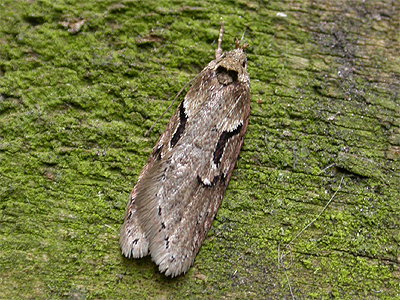 |
| ..... |
| Do not be put
off by those insisting that "micros are
impossible", because most are not and the
off-putting use of scientific names, do become very much
easier with time and frequent use. A good tip is to
initially break the scientific name up, so that Semioscopis
becomes (Semi-osc-opis) and avellanella
becomes (avell-an-ella) and steinkellneriana
becomes (stein-kell-neri-ana) In terms of their Nottinghamshire distribution, we know very little about both species, but their range does seem to be genuinely restricted with S. steinkellneriana seemingly the rarer moth of the two. S. avellanella is a moth of mature Birch woodland and is common throughout the Sherwood Forest area, where it is often found resting on the trunks of trees during the day. There are no records of S. steinkellneriana from Sherwood Forest (probably due to habitat) as it shows a preference for old hedgerows, woodland and woodland edges containing Blackthorn, probably on heavier soils. |
||
| ..... |
| 32.001 .... B&F 0666 .... Semioscopis avellanella (Hübner, 1793) |
Nottinghamshire status and distribution: In terms of numbers, Semioscopis avellanella is considerably more numerous than Semioscopis steinkellneriana, although the two species do occur together at a few locations. It can often easily be found by day on the trunks of trees. There are isolated records from Bevercotes Pit Wood and Holborn Hill Plantation, but the majority of our own records are from the Sherwood Forest and Eakring area. It seems to be a genuinely uncommon moth over the best part of Nottinghamshire, unknown even from sites where recording moths traditionally starts early in the year. Flight period: Flies from mid-March to mid-May. Our own records have showed a general peak in late March, with a few moths appearing after the peak flight period. Is attracted to MV light. Identification features: Adults always have a light grey background colouration to the forewings, lightly flecked with black. This makes resting moths easy to find on the trunks of trees during the day. |
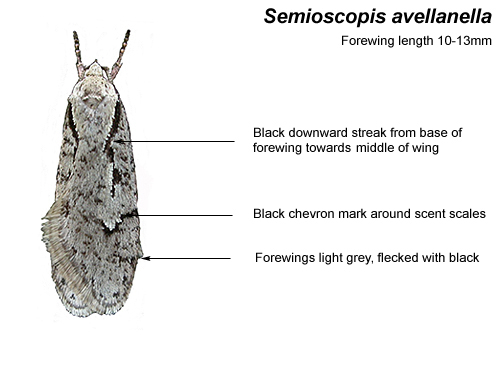 |
| ..... | |||||
| The only real obvious markings on the forewing, are a black, downward streak, running from near the base of the forewing. Near its end, is another (slightly less discernable) short streak, running off at a slightly different angle towards the middle of the forewing. There is a raised patch of scent scales, outlined by a small chevron mark, which reaches the leading edge of the forewing. | |||||
| ..... | |||||
|
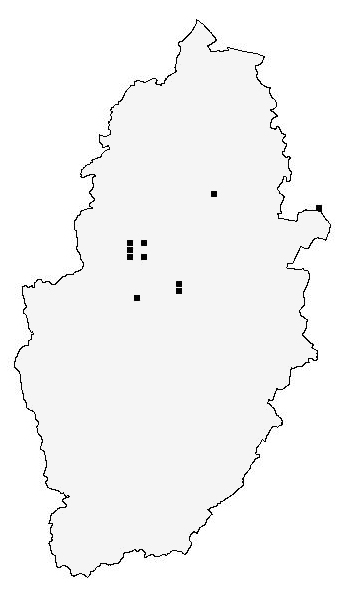 |
||||
| 32.002 .... B&F 0667 .... Semioscopis
steinkellneriana ([Denis & Schiffermüller], 1775) |
||
Nottinghamshire status and distribution: This seems to be a genuinely uncommon moth in Nottinghamshire and of the two Semioscopis sp, this is by far the rarer of the two. We have trapped this moth on just three occasions, from Lound Wood and Kirton Wood, both woodlands being sited on rather heavy soils and there is another recent record from Gamston Wood near Retford. Flight period: Flies early in the year, during March and April. Our own three records have all occurred between the inclusive dates of April 4th and 22nd. Identification features: Has a similar resting posture and overall wing shape when at rest, to Agonopterix heracliana and other Agonopterix species. The most obvious ID feature is the prominent dark brown to black downward streak running part way down the length of the forewing, ending near a semicircle of dark scales in the discal area of the forewing. |
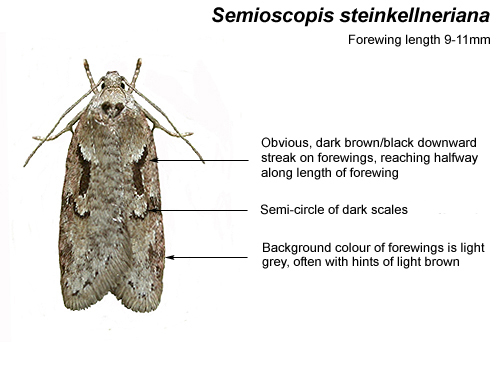 |
|
| ..... | ||
| In the field, this is an obvious feature but some experience of Semioscopis avellanella is often needed at first before the two moths become easily seperable. Experience gained, this moth becomes much quicker to identify. | ||
| ..... | ||
|
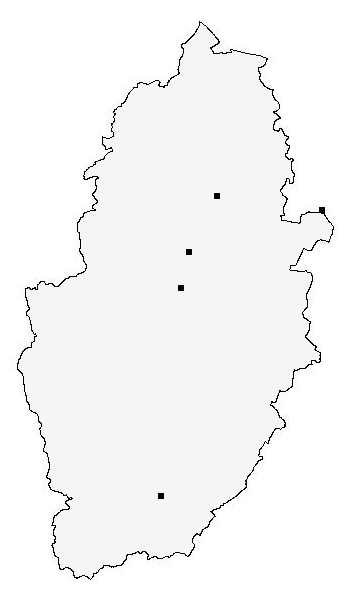 |